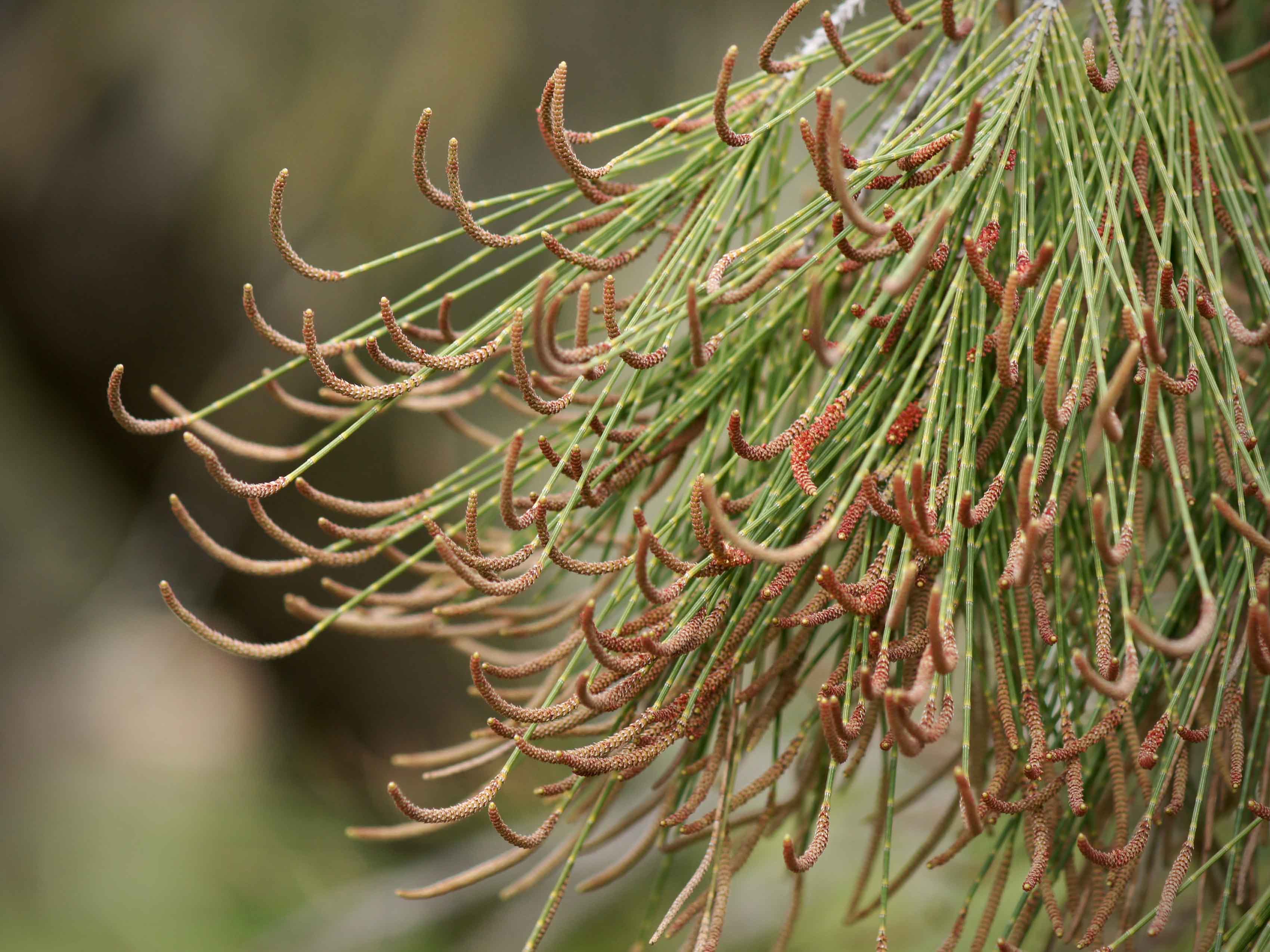Casuarina cunninghamiana
 river she-oak
river she-oak
Superficially resembling pines because of their needle-like branchlets, the casuarinas also bear small cone-like fruit and form beds of dry needles resembling the mat under a pine tree. Their dark-red tough wood is responsible for the occasional name beefwood, while the wide medullary rays suggested the name oak. Though the timber was shipped to Britain from Australia, it was not equal to oak imported from Britain; hence the prefix she- (we are talking about 1800 here!). The wood was used in the past for making boomerangs and clubs. Small red flowers – a red tangle of thread-like pistils – on female trees make it clear that something unusual is going on and examination of the needles with a lens reveals tiny leaves in the form of teeth surrounding the needles at junctions that are clearly visible to the naked eye. River she-oak has eight leaf teeth, plus or minus two, and the cones are about ¼ inch in diameter. To count the teeth it helps to pull the needle apart at a joint, at which point the teeth are displayed like a crown. Evidently the tree’s photosynthesis function has been taken over by the chlorophyll in the stems. The cones are barrel shaped and formed of rings of bivalves, the number in each ring being about the same as the number of leaf teeth. The arrangement does not follow the spiral plan of the conifers. Each bivalve opens meridionally to release one winged seed (samara).
In its natural habitat it grows in river beds and on their banks. In New South Wales, its principal native habitat, where it grows to 100 feet high and 4 feet in diameter, river she-oak is a protected species on account of growing on and stabilizing river banks.

Most of campus’s she-oaks are scattered around the Arboretum. Nine can be seen growing in harsh conditions on the south side of Roth Way, east of Lomita Drive; even so, two have reached 60 feet in height. A group of six, males and females, is on Lasuen Street midway between Campus Drive East and Arboretum Road, near the pepper trees. There are a dozen nearby on the closed road that bisects the intersection of Lasuen Street and Campus Drive. A group along the south side of Campus Drive, at the Anderson Collection, seems to be the remnant of a double row. The casuarina is a battler, it has survival value in neglected areas, and many – Australians in particular – deem it easy on the eye.
On central campus, a tall specimen stands at the west side of Roble Gym. A group of what might be a hybrid was planted in 2020, campus’s most recent use, along the east side of Campus Drive near Quillen Highrise.
The name Casuarina was given by Linnaeus in 1759 because of resemblance to the plumage of the cassowary, a 5-foot high, shy flightless bird native to New Guinea, northeast Australia, and some adjacent islands. The species name refers to Alan Cunningham, a colorful botanical explorer of the early 1800s, who is memorialized by an obelisk in the Royal Botanical Gardens, Sydney.
Related material: Field Guide to Identify the Common Casuarina (Australian Pine) Species in Florida by William S. Castle offers excellent field identification advice.
About this Entry: The main text of this entry is from the book Trees of Stanford and Environs, by Ronald Bracewell, published 2005. First mentions of cones and needles changed to cone-like fruit and needle-like branchlets (Jan 2018, SP). Revised, with edits and new locations: Roble Gym and Quillen (Dec 2023, SP).





